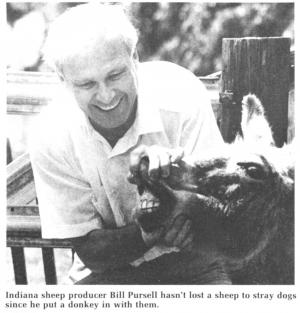1981 - Volume #5, Issue #5, Page #19
[ Sample Stories From This Issue | List of All Stories In This Issue | Print this story
| Read this issue]
Ewe'll Be Pleased With Guard Donkeys
 |
The "new" method consists of running one or several donkeys with the sheep. Donkeys scare off predators with their aggressive, protective actions.
George Haenlein, professor of animal science at the University of Delaware, says a baby donkey should be taken at birth and raised on a ewe. "It will grow up thinking of the sheep flock as his family. This is a phenomenon called imprinting," notes Haenlein.
Since donkeys are naturally protective, they will defend their "family" against predators by biting, explains Haenlein. "First, they bare their teeth intimidatingly ù like dogs do. Then, they attempt to chase the predator away. If they catch up to the animal they'll bite it. Donkeys have powerful jaws and can inflict a very painful bite," explains Haenlein.
He notes that various versions of "imprinting" have been used in Europe for many years. Puppies from certain breeds of dogs, such as Komondor and Great Pyrenees, are raised on ewes and spend the rest of their life defending their flock, he points out.
One problem with using dogs for "imprinting" is that they are meat eaters and must have humans around to feed them or they will prey on the animals they are supposed to defend. Donkeys, on the other hand, are grazing animals, the same as sheep, and can thus be left unattended indefinitely with a flock of sheep or goats in remote pastures.
Indiana sheep producer Bill Pursell, of Spencer, was regularly losing sheep to stray dogs when, in 1976, he decided to try the idea of putting a donkey in with his sheep flock. He says he hasn't lost another sheep since to stray dogs.
Pursell puts an adult female donkey with a newborn foal in with his 35 ewes. "Since the mild-mannered sheep post no threat to her foal, the mother donkey adopts the entire flock as her family," Pursell points out. "If a dog comes after the sheep, the donkey protects them. When she runs out to defend them against the dog, the sheep close rank behind her. That's usually enough to scare the dog away."
Pursell paid $125 for his donkey and feeds her about $75 worth of hay a year. "That's pretty cheap insurance," he notes.
Haenlein thinks a system like Pursell's could be a way to utilize burros which the National Parks Service is trying to get out of the Grand Canyon.
A free publication, "So You'd Like To Adopt A Wild Horse Or Burro?" tells how to apply for and care for a wild burro. It's available through the government's Consumer Information Center, Dept. B, Pueblo, Colo. 81009.
For more details, contact: FARM SHOW Followup, George Haenlein, animal science dept., University of Delaware, Newark, Del. 19711 (ph 302 738-2524); or Bill Pursell, Rt. 3, Box 480, Spencer, Ind. 47460 (ph 812 829-2303).

Click here to download page story appeared in.

Click here to read entire issue
To read the rest of this story, download this issue below or click here to register with your account number.




